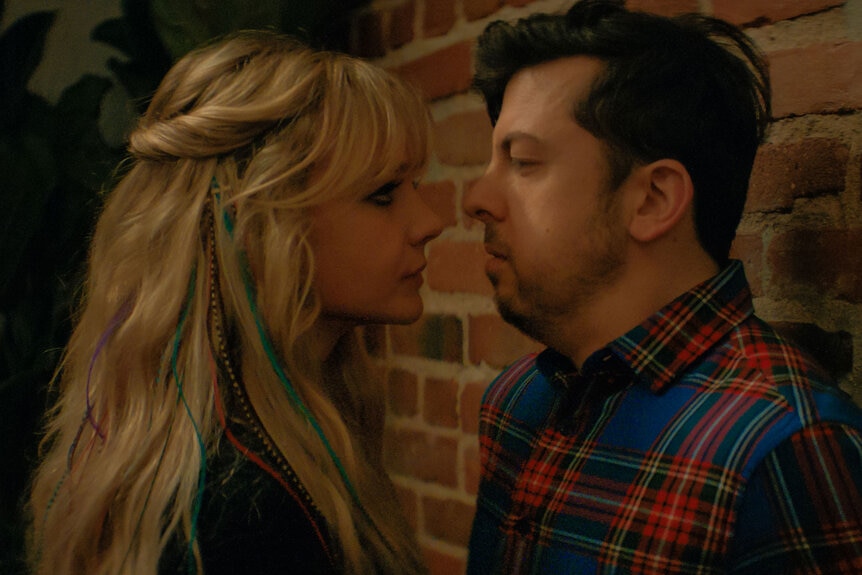Create a free profile to get unlimited access to exclusive videos, breaking news, sweepstakes, and more!
I Found 'Promising Young Woman' Therapeutic And Think Others Affected By Sexual Assault Might Too
In "Promising Young Woman," director Emerald Fennell takes the "promising young man" trope and turns it on its heading, giving power back to sexual assault survivors like myself.

The film “Promising Young Woman” takes the powerlessness that many women feel in connection to sexual assault and turns it on its head, honing in on that female rage and giving it a bright pink and powerful light. As someone who was left feeling powerless after unsuccessfully trying to get someone I feel was a serial predator convicted, it was certainly therapeutic for me.
(Warning: Spoilers ahead)
The film stars Carey Mulligan as Cassandra Thomas, a woman who becomes a vigilante in the wake of her childhood best friend Nina’s rape. Nina was attacked by their so-called friends while they were both bright med school students. The school sided with the boys, who videotaped and mocked the assault, while Nina's trauma was dismissed. It’s hinted that she died by suicide as a result.
While the film (which is distributed by Focus Features LLC, a division of NBCUniversal Media, LLC) is marketed as both a dark comedy and a revenge fantasy, many details indeed mirror real cases. Canadian Rehtaeh Parsons died by suicide in 2013 following an alleged 2011 gang rape and subsequent bullying by her classmates. Images of the alleged rape were shared by the boys involved and many in the town sided with them. The suspects weren't charged with rape but, following Parsons’ death, two were convicted on child porn charges. Just this year, Daisy Coleman, whose sexual assault case was featured in the 2016 Netflix documentary “Audrie & Daisy," died by suicide. Her mom, who died months later by suicide too, attributed her death to the incident. After her assault allegations, disparaging rumors about Daisy Coleman were spread around her school and rural town. She was ostracized and harassed and her family’s house also mysteriously burned down following the rape accusations, KCUR in Kansas City, Missouri reported in 2016.
The title of the film itself, “Promising Young Woman,” also parallels how certain attackers are viewed and treated within the criminal justice system. Brock Turner, a Stanford University student who sexually assaulted Chanel Miller while she was unconscious in 2015, was infamously sentenced to just six months in jail and three years of probation. The judge in the case, Aaron Persky, cited the numerous character letters written on Turner's behalf as part of his reasoning to levy such a light punishment. While director Emerald Fennell doesn’t think the title is a direct twist on that particular case, she told Yahoo! Entertainment that the phrase is “commonly used when young men do something wrong.”
“They are almost always referred to as ‘promising young man’ whether it’s a case like this of assault or if they get a gun and do something completely reprehensible,” she said. “There’s always this inclination to be forgiving. I believe entirely in forgiveness, but it’s an interesting thing, when you look at the phrase ‘promising young woman,’ it’s hardly ever used, and if it is used, it’s usually to describe a girl who’s no longer alive. [...] You can only really be a ‘promising young woman’ when it’s too late, when your promise is completely aborted.”
Thomas reacts to the injustice of her friend’s attack by disregarding her promising future as a doctor, dropping out of school, and dedicating her life — for years — to vigilante justice. She regularly feigns intoxication at bars and clubs to lure in would-be rapists. She pretends to stumble and slur and, at times, fakes passing out to see who would try to take advantage of her. After appearing to be easy prey, she’ll turn the tables on her attackers and reveal that she is actually sober and quite pissed. Often the men react with fear and anger, but in nearly all those cases, Thomas is in full control. The power shifts to her favor, despite many of the men’s pleas that they're merely “nice guys” acting now as though they're the ones being violated. The film features a recent remake of the 1983 disco hit "It's Raining Men," which, in the context of the movie, takes on a new sinister vibe.
The surreality of such scenes are heightened by the film’s stylized aesthetics: lots of neon and pink and extra girly music with a bleak undertone. Despite the colorful backdrop, Thomas' outlook is bleak. She has no more aspirations or dreams. She just wants to focus on getting revenge. While she doesn’t kill anyone, she becomes a modern-day Charles Bronson character, with less machismo, from the 1974 movie “Death Wish.” In that film, Bronson plays a New York City architect who becomes a hardened vigilante after a brutal attack on his wife and daughter.
Not only does Thomas prey on possible predators, but she makes it her personal mission to get justice for Nina. In one scene, she essentially kidnaps the teen daughter of her medical school’s dean in an effort to get an apology for the way the school treated Nina. Thomas is successful in doing so. She then tricks an old classmate named Madison, who didn’t believe Nina following the assault, into getting too drunk so Thomas can stage a scene. She made Madison feel as though she had been sexually assaulted herself, leading Madison to also show some remorse.
From there, Thomas goes over to the home of a defense lawyer who threatened and bullied Nina until she dropped her case. The lawyer, who admits that he had an epiphany-slash-“psychotic break” over what he did for a living, offers submissively that he deserved to be hurt for what he had done. He also notes that there is a guy at his office whose only job is to comb through women's’ social media accounts to find “any compromising information.”
“One drunk photo at a party, oh you wouldn’t believe how hostile that makes a jury,” he says.
This scene particularly resonated with me because when I tried to get a man indicted for rape, such “compromising information” was dug up on me by a defense lawyer. More accurately, I and another woman he also allegedly raped months prior did get him indicted for rape in 2010 — the prosecution had us testify in front of a grand jury on the same day — but by 2012 that indictment was dropped for reasons that have still not been fully explained to me. I testified in front of a grand jury again in 2012, this time solo because the other victim no longer wanted to. Her alleged attack, as well as another that the man was linked to, couldn’t be mentioned during the second grand jury process, thus the case was weakened. It ended up being thrown out but not before the prosecutor’s office showed me a folder of information about me that the suspect’s lawyer had collected by combing my digital footprint.
So-called damning evidence collected off my social media included photographs of me in bathing suits, a costume from the Mermaid Parade, and Halloween, all occasions when nearly everyone in attendance is dressed in scarce amounts of clothing. There was also a picture of me wearing a bikini top and shorts, standing in a pool on the top of a rooftop during a Fourth of July party during an especially muggy and humid night. The photographs were supposed to “prove” that I was both promiscuous and a party girl.
While these images never made it into the courtroom itself, to this day I am still disturbed that they could be considered possible incriminating evidence in such a case. I still fail to see a logical correlation between one's ability to put on certain items of clothing, or not, to one's ability to be a credible rape victim. So, to see a rapist's attorney hunched over on a couch in the face of a female vigilante, begging for forgiveness, I cannot help but grin.
Sure, it’s not a likely scenario but it would be nice to believe that people like him do have remorse for such actions. After all, rape survivors are wrongfully taught that we are supposed to feel remorse for living a full life, as the film accurately depicts. For example, I was essentially shown that I was wrong for choosing to dress up on Halloween and for wearing a bikini to the beach. In "Promising Young Woman," Nina's former classmate shames her for drinking despite the fact that she died as a result of dealing with the sexual assault.
Thomas forces characters who prey on women, as well as those who are complicit, to feel remorse. Fennell explained to Entertainment Weekly that while she doesn’t believe in “villains,” the film is, in part, an attempt to get people to look inward at internalized sexism. The film forces those who made mistakes, and I'm not talking about the sexual assault survivors themselves, to examine those mistakes. The film shows us how we, as a whole, have made mistakes in how we have been treating sexual assault and how there is much work to be done, both at a societal level and individually.
However, putting in the work to improve is often a job unfairly left for just the survivors to do. Before Coleman’s death, she was open about doing EMDR (eye movement desensitization reprocessing) therapy for the trauma she endured. During such therapy sessions, a person revisits the traumatic event with the hope that they can attach more positive associations to it, thus lessening its negative effect on them. I myself have started EMDR therapy sessions specifically for my 2010 incident and its aftermath, and while I can’t speak to how successful it is yet, watching “Promising Young Woman” felt like a therapy session in and of itself. Some scenes were mildly triggering, but the powerless feelings I attached to the memories were replaced with power through this fantasy.
The movie is a much-needed punch in society's gut three years after the advent of the #MeToo movement, a movement that Fennell told Entertainment Weekly did not directly inspire the film. Rather, the feminist eruption just happened to occur around the same time. It was as if women collectively decided that they couldn’t be silent about such injustices any longer.
“The thing about the #MeToo movement, it’s stuff we’ve all been talking about among ourselves, together,” she said. “Some of the details were a shock, but none of it was a shock to anyone who’s lived in the world as a woman, unfortunately.”
And hopefully, for anyone who has experienced the world as a woman — and furthermore for anyone who has been affected by sexual assault — the film will make for a therapeutic and hopeful watch. It certainly was that for me.



























